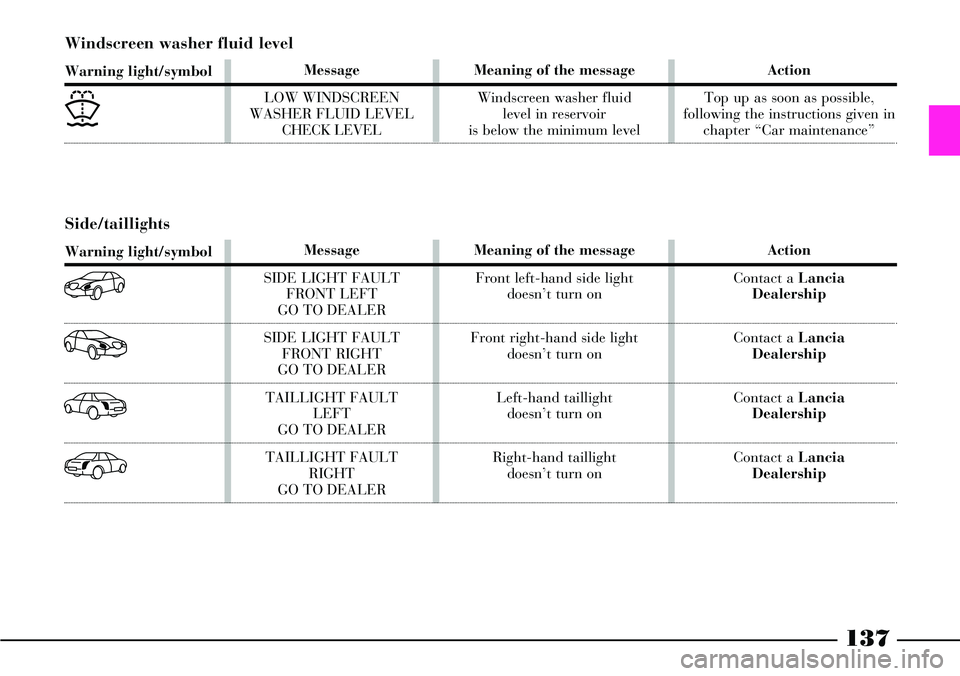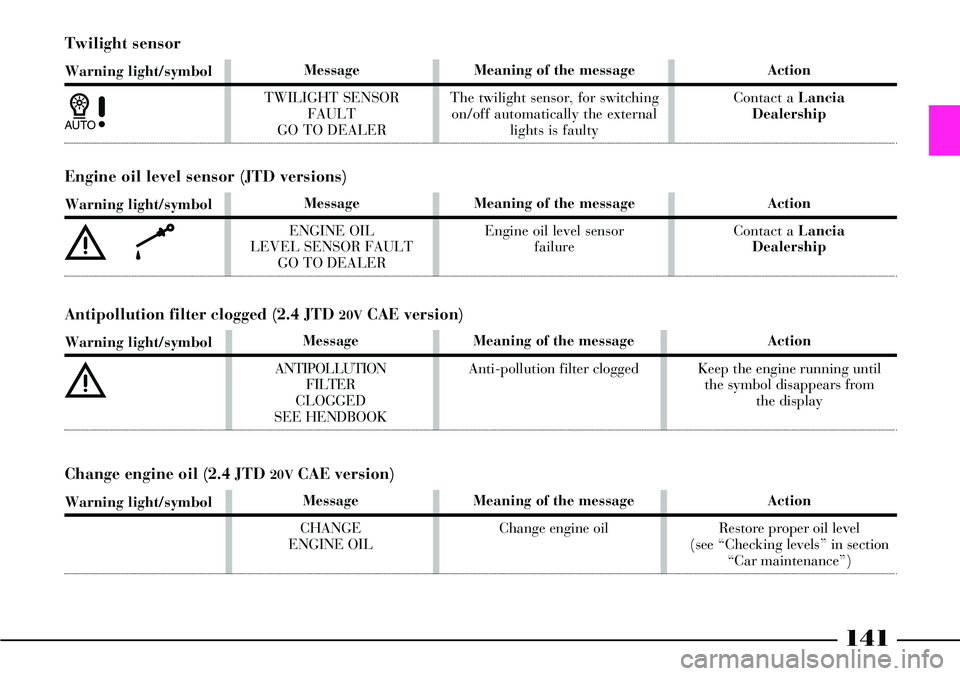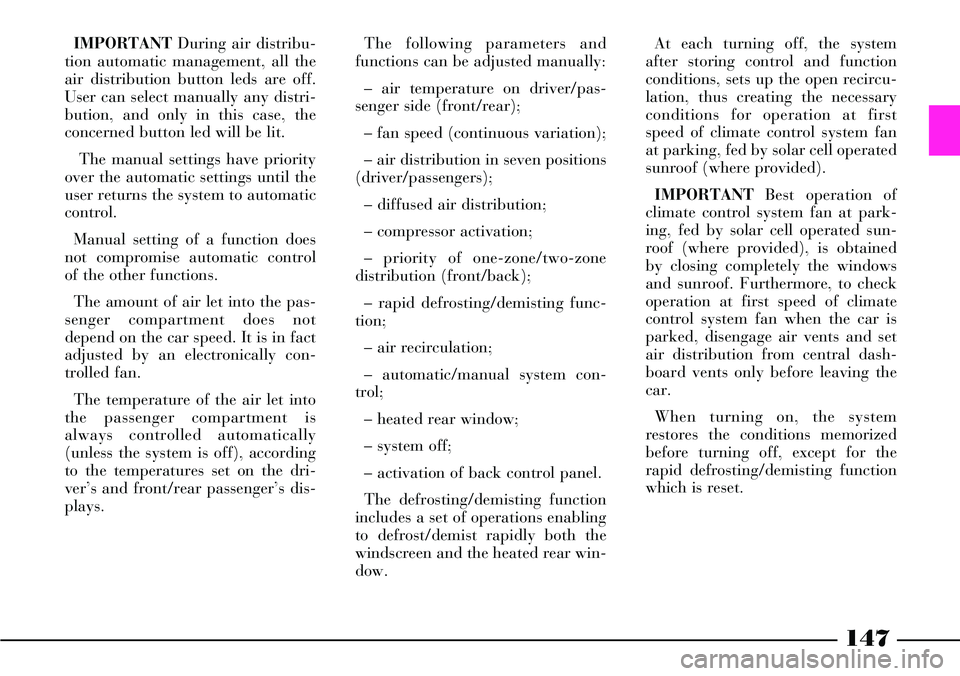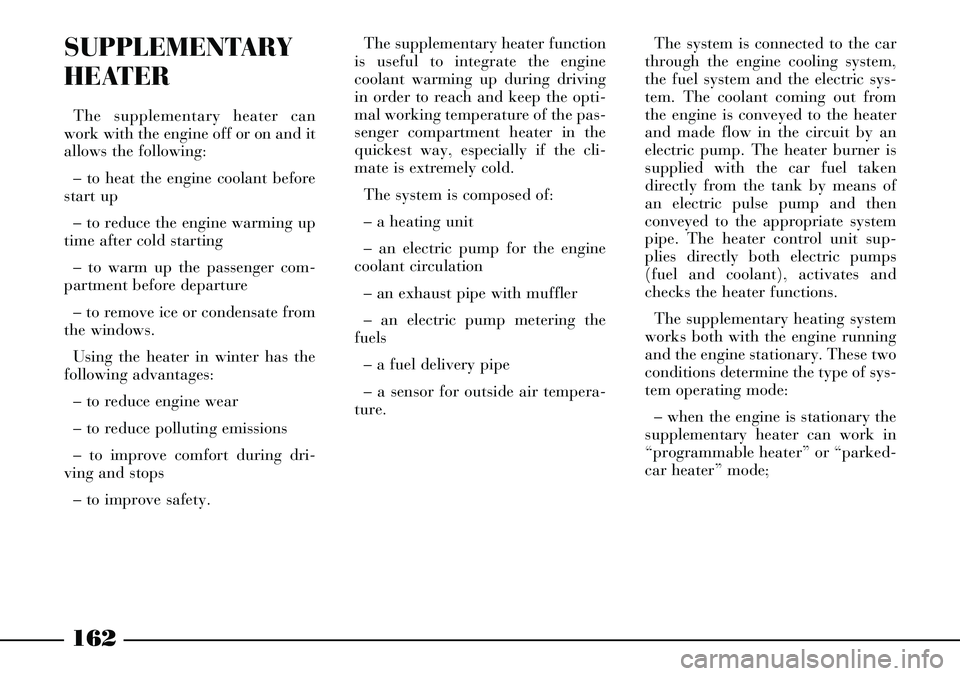Check Lancia Thesis 2007 Owner handbook (in English)
[x] Cancel search | Manufacturer: LANCIA, Model Year: 2007, Model line: Thesis, Model: Lancia Thesis 2007Pages: 386, PDF Size: 8.69 MB
Page 138 of 386

137
Windscreen washer fluid level
Warning light/symbol
)
Message
LOW WINDSCREEN
WASHER FLUID LEVEL
CHECK LEVEL
Meaning of the message
Windscreen washer fluid
level in reservoir
is below the minimum levelAction
Top up as soon as possible,
following the instructions given in
chapter “Car maintenance”
Side/taillights
Warning light/symbol
k
l
m
n
Message
SIDE LIGHT FAULT
FRONT LEFT
GO TO DEALER
SIDE LIGHT FAULT
FRONT RIGHT
GO TO DEALER
TAILLIGHT FAULT
LEFT
GO TO DEALER
TAILLIGHT FAULT
RIGHT
GO TO DEALERMeaning of the message
Front left-hand side light
doesn’t turn on
Front right-hand side light
doesn’t turn on
Left-hand taillight
doesn’t turn on
Right-hand taillight
doesn’t turn onAction
Contact a Lancia
Dealership
Contact a Lancia
Dealership
Contact a Lancia
Dealership
Contact a Lancia
Dealership
Page 142 of 386

141
Twilight sensor
Warning light/symbol
1
Message
TWILIGHT SENSOR
FAULT
GO TO DEALERMeaning of the message
The twilight sensor, for switching
on/off automatically the external
lights is faultyAction
Contact a Lancia
Dealership
Engine oil level sensor (JTD versions)
Warning light/symbol
èk
Message
ENGINE OIL
LEVEL SENSOR FAULT
GO TO DEALERMeaning of the message
Engine oil level sensor
failureAction
Contact a Lancia
Dealership
Message
ANTIPOLLUTION
FILTER
CLOGGED
SEE HENDBOOK
Meaning of the message
Anti-pollution filter cloggedAction
Keep the engine running until
the symbol disappears from
the display
Antipollution filter clogged (2.4 JTD 20VCAE version)
Warning light/symbol
è
Message
CHANGE
ENGINE OILMeaning of the message
Change engine oilAction
Restore proper oil level
(see “Checking levels” in section
“Car maintenance”)
Change engine oil (2.4 JTD 20VCAE version)
Warning light/symbol
Page 146 of 386

AIR VENTS
The car is fitted with three air
vents set on the dashboard: two
vents A(fig. 118) on driver side and
one B (fig. 119) on passenger side,
sending air in the passenger com-
partment in a “diffused” mode.
This particular function conveys air
at low speed, about half of the usual
flow, through additional vents.
Moreover, it reduces the air impact
on the passengers and the noise due
to the air coming out of the vents,
thus improving the passengers' com-
fort.IMPORTANTWhen the outside
temperature is very high (over 30°C),
to reach the selected temperature as
soon as possible, it is suggested to op-
erate air vents only after the system
has reached steady working condi-
tions.
IMPORTANTOn versions equipped
with solar cell operated sunroof
(where provided), to check operation
at first speed of climate control sys-
tem fan when the car is parked, dis-
engage air vents and set air distribu-
tion from central dashboard vents
only before leaving the car.
fig. 119
L0A0060b
fig. 120
L0A0059b
fig. 118
L0A0061b
145
Air vents (open) are actually used
only when the control for directing
air flow on the instrument panel is
operated.
Air vents are opened by rotating
the dashboard central vent knobs
beyond the upper stop limit (fig.
120):
– control Afor air vents on driver
side
– control Bfor air vent on passen-
ger side.
At the stop limit of these controls
there is a button which, if pressed,
sends a signal to the climate system
control unit.
Page 147 of 386

146
AUTOMATIC
CLIMATE
CONTROL SYSTEM
GENERAL
The car can be equipped with a
two-zone or multi-zone automatic
climate control system.
The two-zone climate control sys-
tem controls temperature, air distri-
bution and flow inside the passenger
compartment in two areas: driver
side and passenger side.
The multi-zone climate control sys-
tem controls temperature, air distrib-
ution and flow inside the passenger
compartment in three areas: driver
side, passenger side or back-seat pas-
sengers.
Control of front-seat passenger and
back-seat passengers is alternated;
when the button led REARis turned
off, the front-seat passenger control
is operating, whereas when button
REARis pressed (button led turned
on), the back control panel is acti-
vated, thus excluding those for the
front-seat passenger.Temperature check is based on the
“heat balance” concept, which
means that the system works con-
stantly to keep a regular balance
between incoming and outgoing heat
energy, in order to stabilize temper-
ature inside the passenger compart-
ment and compensate possible vari-
ations of outside climate, sun radi-
ance included. For optimal control
of temperature in the two areas of
the passenger compartment, the sys-
tem is equipped with a sun ray sen-
sor.
The system features a pollution
sensor which can automatically
switch the air recirculation function
on to reduce the unpleasant effects
of polluted air in cities, queues, tun-
nels and when the windscreen wash-
er is operated (with the characteris-
tic smell of alcohol).
The air quality is controlled by an
active carbon dust/pollen filter
which has the double function of
mechanically filtering the particles
dispersed in the air and attenuating
the peak accumulation of certain
pollutants.Parameters and functions auto-
matically controlled are the follow-
ing:
– temperature of air let into dri-
ver/passenger vents (front-seat/
back-seats);
– air distribution to vents on dri-
ver/passenger side (front-seat/
back-seats);
– fan speed (continuos variation of
air flow);
– compressor activation (to cool
air);
– air recirculation.
All these functions can be adjusted
manually, it means that one or more
system functions can be selected and
that it is possible to change their
parameters. However, in this way
the system is unable to control man-
ually selected functions which will
be changed by the system only for
safety reasons, while keeping the
required temperature.
Page 148 of 386

147
IMPORTANTDuring air distribu-
tion automatic management, all the
air distribution button leds are off.
User can select manually any distri-
bution, and only in this case, the
concerned button led will be lit.
The manual settings have priority
over the automatic settings until the
user returns the system to automatic
control.
Manual setting of a function does
not compromise automatic control
of the other functions.
The amount of air let into the pas-
senger compartment does not
depend on the car speed. It is in fact
adjusted by an electronically con-
trolled fan.
The temperature of the air let into
the passenger compartment is
always controlled automatically
(unless the system is off), according
to the temperatures set on the dri-
ver’s and front/rear passenger’s dis-
plays.The following parameters and
functions can be adjusted manually:
– air temperature on driver/pas-
senger side (front/rear);
– fan speed (continuous variation);
– air distribution in seven positions
(driver/passengers);
– diffused air distribution;
– compressor activation;
– priority of one-zone/two-zone
distribution (front/back);
– rapid defrosting/demisting func-
tion;
– air recirculation;
– automatic/manual system con-
trol;
– heated rear window;
– system off;
– activation of back control panel.
The defrosting/demisting function
includes a set of operations enabling
to defrost/demist rapidly both the
windscreen and the heated rear win-
dow.At each turning off, the system
after storing control and function
conditions, sets up the open recircu-
lation, thus creating the necessary
conditions for operation at first
speed of climate control system fan
at parking, fed by solar cell operated
sunroof (where provided).
IMPORTANTBest operation of
climate control system fan at park-
ing, fed by solar cell operated sun-
roof (where provided), is obtained
by closing completely the windows
and sunroof. Furthermore, to check
operation at first speed of climate
control system fan when the car is
parked, disengage air vents and set
air distribution from central dash-
board vents only before leaving the
car.
When turning on, the system
restores the conditions memorized
before turning off, except for the
rapid defrosting/demisting function
which is reset.
Page 154 of 386

153
To switch this function off, turn
the temperature knob to the left and
set the required temperature.
– LOfunction (maximum cooling):
it is activated by turning the temper-
ature knob to the left beyond the
minimum value (16 °C). It can be
independently switched on from dri-
ver’s side or from (front/back) pas-
senger’s side or from both sides (also
by selecting the MONOfunction).
This function can be switched on to
speed up cooling the passenger com-
partment by exploiting the system
potential to the maximum. This
function cuts out the heater and
switches the air recirculation and the
climate control compressor on. The
air distribution and the fan speed
are selected according to the envi-
ronmental conditions. All the manu-
ally settings can be adjusted when
the function is on. To switch this
function off, turn the temperature
knob to the right and set the
required temperature.Buttons for adjusting front air
distribution (10, 18 fig. 121)
Press these buttons to manually
select one of the seven possible air
distribution patterns in the front
passenger compartment (right and
left side):
AAir flow to windscreen and front
side window vents for defrosting/
demisting the windows.
FDAir flow to central and side
dashboard vents and the rear vents.
IMPORTANTOn versions equipped
with solar cell operated sunroof
(where provided), to check opera-
tion at first speed of climate control
system fan when the car is parked,
disengage air vents and set air distri-
bution from central dashboard vents
only before leaving the car.
SAir flow to the front and rear
footwells. The air distribution pat-
tern, due to the natural tendency of
heat to move upwards, allows to
heat the passenger compartment up
as fast as possible. Furthermore, it
offers a prompt feeling of warmth to
the coolest parts of the body.Air flow shared between
footwell vents (warmer air)
and central and side dashboard
vents and the rear vents (cooler air).
This air distribution pattern is par-
ticularly useful in middle seasons
(spring and autumn) when it is
sunny.
Air flow shared between the
footwell vents and the windscreen
and front side window
defrosting/demisting vents. This air
distribution pattern ensures a good
heating of the passenger compart-
ment and prevents possible misting
up.
Air flow distribution between
central and side dashboard
vents, rear vents and windscreen
and front side window vents.
Air flow distribution
between all passenger com-
partment vents.
Air distribution setting is displayed
when leds relevant to the selected
button are lit, which will be turned
off in case of fully automatic opera-
tion (FULL AUTO). F
SD
A
S
FA
D
FA
SD
Page 162 of 386

161
ACTIVE CARBON
DUST/POLLEN FILTER
The filter has the specific capacity
of combining a mechanical air
cleaning action and an electrostatic
effect so that the air let into the pas-
senger compartment is purified from
particles such as dust, pollen, etc.
In addition to this function, the fil-
ter efficaciously reduces the concen-
tration of pollutants thanks to a
layer of active carbon inside the fil-
ter.
The filtering action is carried out
on the air let in from outside (recir-
culation off).
Have the filter checked at least
once a year at a Lancia
Dealership, ideally at the begin-
ning of the summer.The efficacy of the cli-
mate control system may
be considerably reduced
if the filter is not replaced.Fan actuation is automatic and air
distribution corresponds to the latest
setting made before switching the
car off.
This function is useful especially on
summer days since it greatly reduces
the temperature inside the passenger
compartment as well as the duration
of the cooling cycle after car start-
up, thus avoiding the accumulation
of warm air in the air conditioning
unit lines.
IMPORTANTBest operation of
the fan when the car is parked is
obtained by closing completely the
windows and sunroof. Furthermore,
to check operation at first speed of
the fan, disengage air vents and set
air distribution from central dash-
board vents only before leaving the
car.You should have the filter checked
and if required replaced more fre-
quently if the car is mainly used in
polluted or dusty areas.
VENTILATION DURING A STOP
In versions with sunroof, the roof
top features 21 photovoltaic cells
supplying a maximum power of 24
W to supply the climate control sys-
tem fan when the car is parked with
the roof closed or horizontally pivot-
ing.
Page 163 of 386

162
SUPPLEMENTARY
HEATER
The supplementary heater can
work with the engine off or on and it
allows the following:
– to heat the engine coolant before
start up
– to reduce the engine warming up
time after cold starting
– to warm up the passenger com-
partment before departure
– to remove ice or condensate from
the windows.
Using the heater in winter has the
following advantages:
– to reduce engine wear
– to reduce polluting emissions
– to improve comfort during dri-
ving and stops
– to improve safety.The supplementary heater function
is useful to integrate the engine
coolant warming up during driving
in order to reach and keep the opti-
mal working temperature of the pas-
senger compartment heater in the
quickest way, especially if the cli-
mate is extremely cold.
The system is composed of:
– a heating unit
– an electric pump for the engine
coolant circulation
– an exhaust pipe with muffler
– an electric pump metering the
fuels
– a fuel delivery pipe
– a sensor for outside air tempera-
ture.The system is connected to the car
through the engine cooling system,
the fuel system and the electric sys-
tem. The coolant coming out from
the engine is conveyed to the heater
and made flow in the circuit by an
electric pump. The heater burner is
supplied with the car fuel taken
directly from the tank by means of
an electric pulse pump and then
conveyed to the appropriate system
pipe. The heater control unit sup-
plies directly both electric pumps
(fuel and coolant), activates and
checks the heater functions.
The supplementary heating system
works both with the engine running
and the engine stationary. These two
conditions determine the type of sys-
tem operating mode:
– when the engine is stationary the
supplementary heater can work in
“programmable heater” or “parked-
car heater” mode;
Page 169 of 386

168
- the led comes on for about 2 sec-
onds = the signal has been received
correctly and the heater has been de-
activated
- the led flashes for about 2 seconds
= the signal has not been received.
In the latter case you are advised to
move before trying to deactivate it by
pressing again the OFFbutton.Checking and replacing the
batteries
To check the battery charge, press
ONor OFF: if after about 5 seconds
led Bcomes on with orange colour it
means that the batteries are nearly
down and that they shall be replaced.
The batteries must be replaced with
new ones of the same type, available
at the usual sellers.
Replacing the batteries
Keep the ONand OFFbuttons
pressed for about 10 seconds, until led
Bturns off, to reset the 30 minutes
standard operation length.
Switching the heater off
To turn the heater off, press the re-
mote control button OFFfor 1 or 2
seconds, while keeping the antenna in
vertical position; the positive or un-
successful deactivation is indicate by
the remote control red led Bin the fol-
lowing way:Used batteries pollute the
environment. Dispose of
them in the special con-
tainers as specified by current leg-
islation. Keep batteries away from
open flames and high tempera-
tures. Keep away from children.
Number of flashes of led B
1
2
3
4
5
6Heater activation length
10 minutes
20 minutes
30 minutes
40 minutes
50 minutes
60 minutes
Page 174 of 386

173
If, after an accident, you
can smell petrol or see
that the fuel feed system is
leaking, do not reset the switches
to avoid the risk of fire.Mechanical connections
of outside handles are
active only if the doors
are locked. In case the driver has
activated the central door locking
from the inside and, after an
accident, the inertial switch was
not able to activate the automatic
door unlocking as a result of bat-
tery loss or damage, it will not be
possible to reach the passenger
compartment from the outside.Anyway, door opening
from the outside depends
on their conditions after
the accident: if a door is distorted
it might be impossible to open it
even if it is unlocked. In this case
try to open the other car doors.
Before resetting the fuel
cut-off switch, carefully
check for any fuel leaks or
damages to the car electric devices
(e.g.: headlights).
fig. 129
L0A0273b
If, after an accident, you cannot see
any fuel leaks or damages to the car
electric devices (e.g.: headlights) and
the car is in a fit state to continue its
journey, reset the fuel cut-off switch
and the circuit breaker according to
the following instructions.
Door unlocking in case of
accident
In case of accident with activation of
the inertial switch as a consequence,
door locks are automatically unlocked
to let rescuers reach the passenger
compartment from the outside.Resetting the fuel cut-off switch
(fig. 129)
fig. 130
L0A0030b